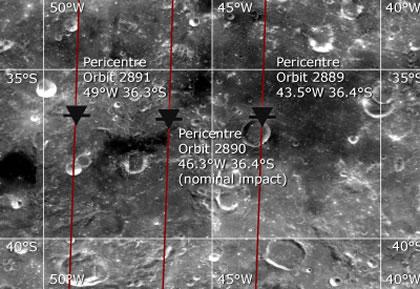The lunar orbiter SMART-1 is due to crash-land on the Moon on 2 or 3 September: dates chosen to help ground telescopes spy on the impact.
The craft will smack into the Lake of Excellence, an area with interesting mineralogy, at a time when this falls just on the dark side of the Moon's border between day and night. That should give both enough contrast and background lighting to see the smash, when the dust it kicks up is highlighted by sunlight and reflected earthshine.
 ESA
ESAThe elliptical descent orbit has been chosen to have the craft hit ground at 05:41 GMT, which will be best for viewing with big telescopes in South America and Northwest America, Hawaii and Australia. But there's a chance it could hit a hill on the passes before that. It could crash down at 00:37 GMT, giving the Canary Islands and South America the best view, or even at 19:33 GMT the previous day, giving Continental Europe and Africa the advantage. See the European Space Agency's website for details on how to view it.
 Read our Moon special to find out more.NASA
Read our Moon special to find out more.NASAWith an impact speed of 2 kilometres per second, SMART-1 should create a crater 5-10 metres in diameter and 1 metre deep: about the same as that made by a 2-kilogram meteorite. Powerful telescopes on Earth should see a faint flash from the strike itself, followed by a 5-kilometre-wide cloud of dust thrown up by the impact.
Observatories around the globe have volunteered to watch the blast, to help work out the characteristics of the minerals beneath the surface. But if the dust cloud is kicked up more than 20 kilometres into the sunshine, then amateurs should also have the fun of spying the sunlit cloud with binoculars and small telescopes.
If you see it, we'd love to publish your observations and pictures. Tell us about it on our newsblog.
